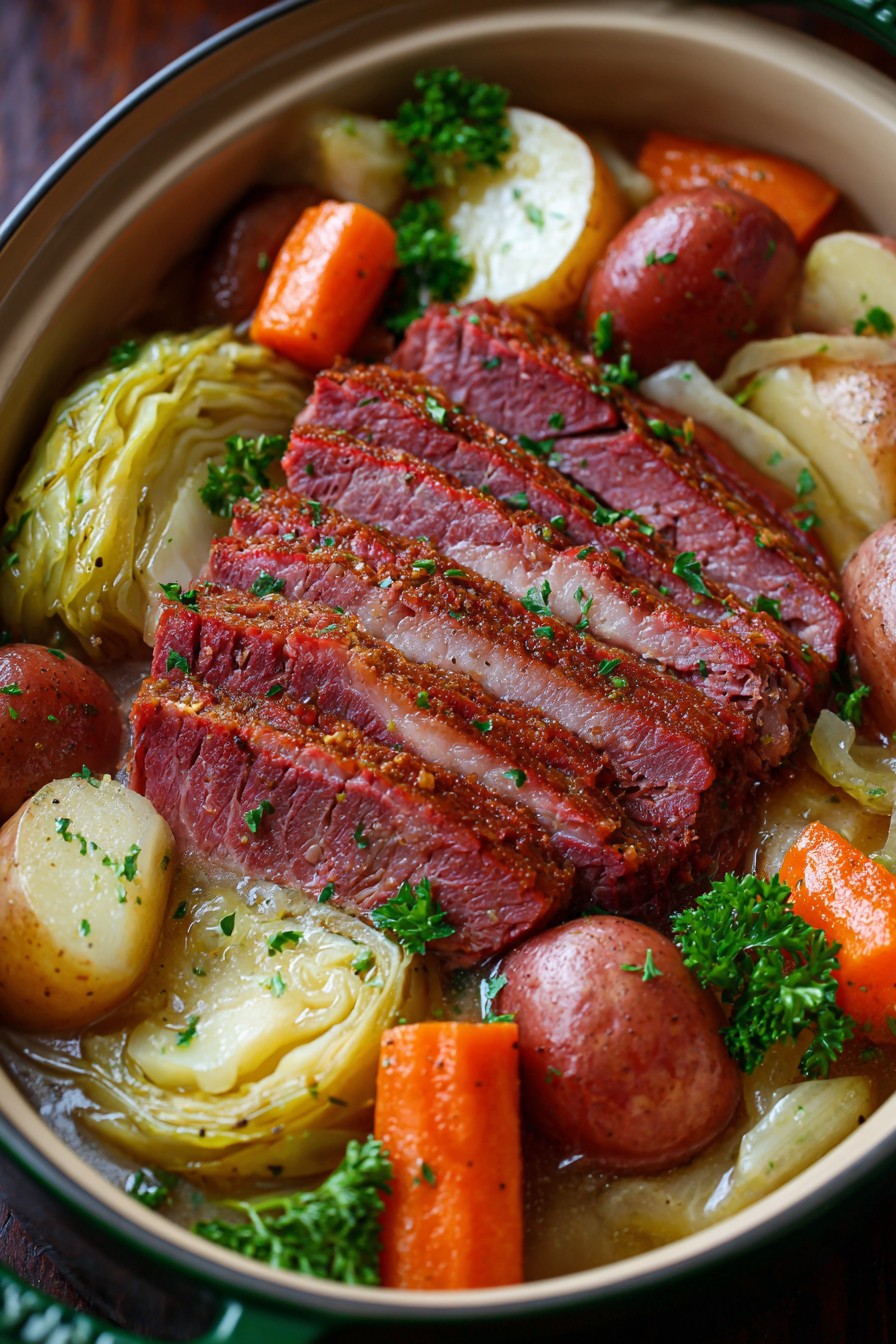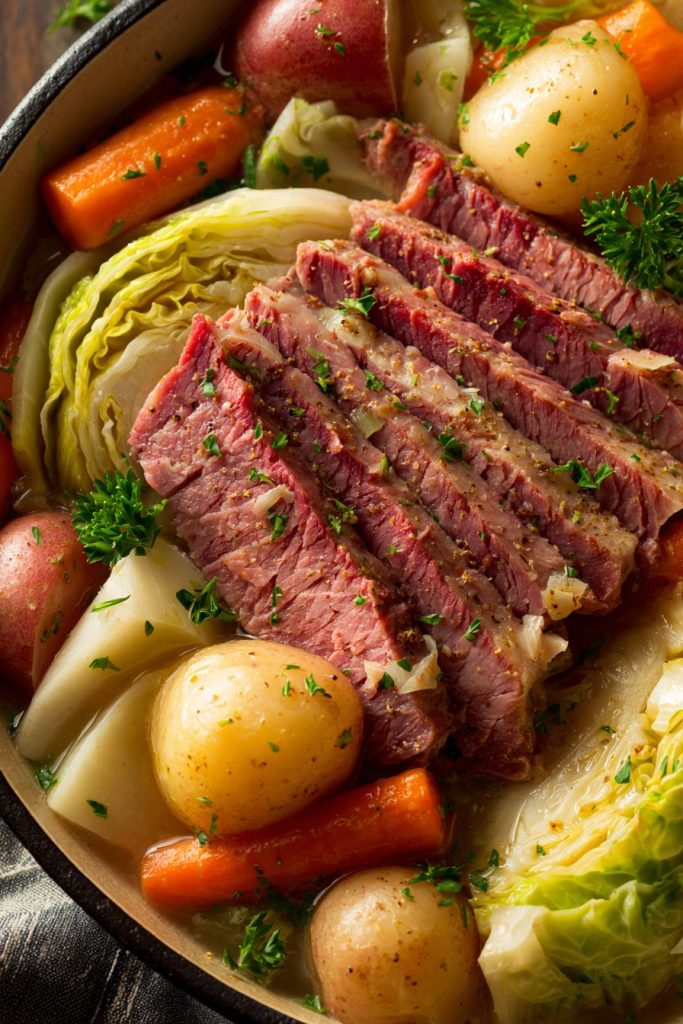Here’s the honest truth about weeknight dinners: you need something that practically cooks itself while you’re juggling homework, laundry, and that mountain of dishes in the sink. Having a reliable one-pot meal that feeds everyone with minimal fuss is my secret weapon for surviving the chaos of family life, and this Dutch oven corned beef and cabbage delivers exactly that kind of stress-free nourishment.
Why This Recipe Works
- The Dutch oven creates an even, gentle heat that transforms tough corned beef into fork-tender perfection without any risk of burning or drying out, giving you consistently excellent results every single time you make it.
- Everything cooks together in one pot, which means you’re not juggling multiple pans or creating a mountain of dishes – just toss everything in and let the magic happen while you tackle other household tasks.
- The vegetables absorb all the delicious flavors from the corned beef seasoning packet and cooking liquid, turning ordinary potatoes and cabbage into something truly special that even picky eaters will happily devour.
- Leftovers reheat beautifully and taste even better the next day, giving you ready-made lunches or another easy dinner option that requires zero additional cooking effort on your part.
- The hands-off cooking approach means you can set it up in under 15 minutes, then walk away for hours while it simmers, making this perfect for busy days when you need dinner to basically make itself.
Ingredients
- 3-4 pound corned beef brisket with seasoning packet included
- 1 large yellow onion, peeled and cut into 8 wedges
- 4 cloves garlic, peeled and smashed
- 2 bay leaves
- 1 tablespoon whole black peppercorns
- 8 cups cold water
- 2 pounds small red potatoes, scrubbed and halved if larger than 2 inches
- 6 medium carrots, peeled and cut into 2-inch chunks
- 1 small head green cabbage, cored and cut into 8 wedges
- 2 tablespoons chopped fresh parsley for garnish
Equipment Needed
- 6-8 quart Dutch oven with tight-fitting lid
- Cutting board
- Chef’s knife
- Tongs
- Slotted spoon
- Instant-read thermometer
Instructions

Preparing the Corned Beef Base
Start by placing your 3-4 pound corned beef brisket fat-side up in your Dutch oven, making sure to include the little seasoning packet that comes with it. Arrange your peeled onion wedges and smashed garlic cloves around the meat, then sprinkle in the contents of the seasoning packet along with the bay leaves and whole black peppercorns. Pour in 8 cups of cold water – it should come about halfway up the sides of the brisket but not completely cover it. The cold water is important here because it allows the meat to heat gradually, which helps prevent it from becoming tough. Bring everything to a boil over high heat, then immediately reduce to the lowest possible simmer and cover with the lid. This gentle cooking method is what transforms that initially tough cut into something incredibly tender without any risk of drying out.
Simmering to Perfection
Once your Dutch oven is at a gentle simmer with the lid securely in place, set your timer for 2 ½ hours and resist the temptation to peek too often. The steam trapped inside creates a self-basting environment that keeps the meat incredibly moist while breaking down all the connective tissue. About halfway through, you can quickly check to make sure there’s still adequate liquid – you should see about an inch of broth at the bottom. If it looks low, add another cup of hot water. The key here is maintaining that steady, low simmer where you see just occasional bubbles breaking the surface. This slow cooking process allows the flavors to develop fully while ensuring every fiber of the meat becomes meltingly tender. Trust the process – this hands-off approach is what makes busy parent cooking so effective.
Adding the Hearty Vegetables
After your corned beef has simmered for 2 ½ hours, carefully remove the lid (watch for steam!) and use tongs to gently lift the meat slightly so you can slide your scrubbed red potatoes and peeled carrot chunks underneath and around it. The potatoes should be submerged in the cooking liquid while the carrots can nestle around the edges. This arrangement ensures everything cooks evenly without overcrowding. Return the lid and continue simmering for another 30 minutes, until the potatoes are easily pierced with a fork but still hold their shape. The vegetables will absorb all those wonderful spiced flavors from the cooking liquid while adding their own natural sweetness to the broth.
Incorporating the Cabbage
Now it’s time to add your cabbage wedges by carefully tucking them around and on top of the other vegetables, making sure they’re partially submerged in the flavorful broth. The cabbage cooks relatively quickly compared to the other components, so you only need about 15-20 minutes with the lid on until it becomes tender but still has a bit of texture. You’ll know it’s ready when the thickest parts of the wedges can be easily pierced with a knife but aren’t mushy. This timing prevents the cabbage from becoming waterlogged while allowing it to soak up all the delicious corned beef flavors. The cabbage adds that final layer of vegetable goodness that makes this feel like a complete, balanced meal.
Resting and Serving
Once everything is cooked through, use tongs to transfer the corned beef to a cutting board and let it rest for 10-15 minutes before slicing against the grain. This resting period allows the juices to redistribute throughout the meat, ensuring every slice stays moist and tender. While the meat rests, use a slotted spoon to arrange the vegetables on a large serving platter or directly onto dinner plates. Slice the corned beef into ¼-inch thick pieces and arrange them alongside the vegetables. Spoon a little of the cooking liquid over everything to keep it moist, then sprinkle with fresh chopped parsley for a bright finishing touch. The beauty of this serving method is that everything comes together at the same time with minimal last-minute fuss.
Tips and Tricks
If you’re dealing with particularly picky eaters, consider cutting the vegetables into smaller, more uniform pieces that might be more appealing to little ones. The carrots can be sliced into coins rather than chunks, and the potatoes can be quartered if your family prefers smaller portions. For even more flavor development, you can let the cooked corned beef cool completely in its cooking liquid overnight in the refrigerator, then reheat it gently the next day – the texture becomes even more tender and the flavors deepen significantly. When shopping for corned beef, look for briskets that have even thickness throughout rather than tapered ends, as this ensures more consistent cooking. If your Dutch oven doesn’t have a super tight-fitting lid and you’re losing too much liquid during cooking, place a sheet of aluminum foil directly over the pot before putting the lid on to create a better seal. For those really hectic days, you can prep all the vegetables the night before and store them in airtight containers in the refrigerator, cutting your active prep time down to just 5-10 minutes. If you end up with leftovers, store the meat and vegetables separately from the cooking liquid – this prevents the vegetables from becoming mushy when reheating. The cooking liquid makes an excellent base for soups later in the week – just strain it and use it instead of broth for vegetable soup or even cooking rice. For easier cleanup, consider lining your Dutch oven with a slow cooker liner before adding ingredients, though make sure it’s rated for stovetop use if you’re starting on the burner.
Recipe Variations
- For a richer flavor profile, replace 2 cups of the water with dark beer or beef broth – the maltiness complements the spiced corned beef beautifully while adding depth to the vegetable flavors.
- Add root vegetables like parsnips or turnips along with the potatoes and carrots for additional vegetable variety and different texture contrasts that can help introduce new flavors to hesitant eaters.
- Create an Irish-inspired glaze by mixing ¼ cup brown sugar, 2 tablespoons Dijon mustard, and 1 tablespoon apple cider vinegar, then brushing it over the corned beef during the last 30 minutes of cooking for a sweet and tangy crust.
- For a lower-carb option, substitute the potatoes with additional cabbage and add cauliflower florets during the last 20 minutes of cooking, creating a vegetable-heavy version that still feels satisfying and complete.
- Transform leftovers into corned beef hash by dicing the meat and potatoes, then pan-frying with chopped onion until crispy for a completely different meal the next morning or evening.
Frequently Asked Questions
Can I make this in a slow cooker instead of a Dutch oven?
Absolutely, and it’s actually a great alternative for days when you want to get dinner started in the morning. Layer the onions and garlic in the bottom of your slow cooker, place the corned beef on top with the fat side up, add the seasoning packet and spices, then pour in enough water to come about halfway up the meat. Cook on low for 8-9 hours or high for 5-6 hours, adding the potatoes and carrots during the last 2 hours and the cabbage during the final 30-45 minutes. The texture will be slightly different but equally delicious, and the convenience of being able to walk away all day can’t be beaten on particularly busy schedules.
How do I know when the corned beef is fully cooked and tender?
The best way to test doneness is by inserting a fork into the thickest part of the meat and twisting gently – if the meat easily shreds or pulls apart with little resistance, it’s perfectly cooked. For those who prefer a more precise method, an instant-read thermometer should register between 190-200°F when inserted into the center of the brisket. However, temperature alone isn’t always reliable with corned beef since tenderness comes from breaking down connective tissue rather than just reaching a specific internal temperature. The meat should feel very soft when pressed and should slice easily against the grain without falling apart.
What’s the purpose of the seasoning packet that comes with corned beef?
That little packet contains a spice blend typically including coriander seeds, mustard seeds, bay leaves, peppercorns, allspice berries, and sometimes cloves or red pepper flakes. These spices complement the brining process that gives corned beef its distinctive flavor and help create the aromatic cooking liquid that seasons all the vegetables. If your corned beef doesn’t include a packet or you prefer to customize, you can make your own blend using 1 tablespoon coriander seeds, 2 teaspoons mustard seeds, 1 teaspoon whole allspice berries, 6 peppercorns, and 2 bay leaves – just tie them in cheesecloth for easy removal after cooking.
Can I prepare this recipe ahead of time for easier weeknight meals?
This dish actually improves when made ahead, making it perfect for meal prep. Cook the complete recipe as directed, then let everything cool completely in the cooking liquid before storing the meat, vegetables, and broth separately in airtight containers in the refrigerator for up to 4 days. When ready to serve, gently reheat the broth to a simmer, add the vegetables to warm through, then slice the cold corned beef and add it just long enough to heat without overcooking. The flavors meld and intensify during storage, and having everything pre-cooked means dinner comes together in about 15 minutes on busy nights.
Summary
This Dutch oven corned beef and cabbage delivers maximum flavor with minimal effort, using one pot to create a complete family meal that practically cooks itself while you handle life’s other demands.
Dutch Oven Corned Beef and Cabbage
6
servings15
minutes3
minutesIngredients
Instructions
- 1 Place corned beef fat-side up in Dutch oven with onion, garlic, seasoning packet, bay leaves, and peppercorns. Add water, bring to boil, then reduce to simmer and cover for 2 ½ hours.
- 2 Add potatoes and carrots around the meat, submerging potatoes in liquid. Cover and simmer 30 minutes until potatoes are fork-tender.
- 3 Tuck cabbage wedges around vegetables, partially submerging in broth. Cover and simmer 15-20 minutes until cabbage is tender.
- 4 Transfer corned beef to cutting board and rest 10-15 minutes. Arrange vegetables on serving platter.
- 5 Slice corned beef against the grain, arrange with vegetables, spoon over some cooking liquid, and garnish with parsley.



